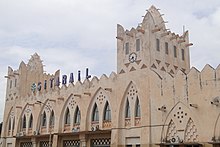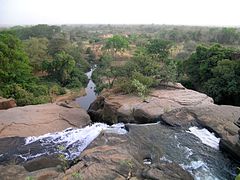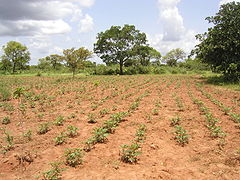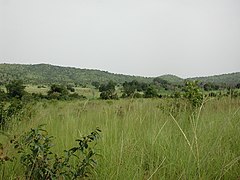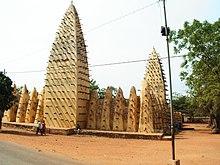Burkina Faso
Burkina Faso is a landlocked country in West Africa bordered to the northwest by Mali, to the east by Niger, to the southeast by Benin, and to the south by Ivory Coast, Ghana, and Togo. As of 2022, the UN estimated its population at 22,673,762. Formerly called the Republic of Upper Volta (1958-1984), the country was named "Burkina Faso" on August 4, 1984 by then President Thomas Sankara. Its citizens are known as Burkinabe, and its capital and largest city is Ouagadougou. Due to French colonialism, the official language of government and business is French, however only 15% of the population speaks it regularly. 59 native languages are spoken in Burkina Faso, with the most common being Mossi, is spoken by approximately 50% of the population.
It gained independence from France on August 5, 1960. After student and union protests, the country's first president, Maurice Yaméogo, was deposed in a 1966 coup led by Sangoulé Lamizana. His rule coincided with a drought and famine in the Sahel, and he was deposed in a 1980 coup led by Saye Zerbo. Again meeting resistance from the unions, the Zerbo government was overthrown by another coup in 1982, led by Jean-Baptiste Ouédraogo.
Thomas Sankara, a Marxist and leader of the leftist faction of the Ouédraogo government, was appointed prime minister but was later jailed.[citation needed] Efforts to freeing him led to the 1983 coup, in which he became president. Sankara launched an ambitious socio-economic program that included an education campaign that increased the literacy level from 13% in 1983 to 73% in 1987, redistribution of land to peasants, the construction of schools, railways and roads and the prohibition of female genital mutilation, forced marriages and polygamy. Sankara was overthrown and assassinated in a 1987 coup led by Blaise Compaoré.
Government instability during the 1970s and 1980s was followed by multiparty elections in the early 1990s. Compaoré was elected president in 1991, 1998, 2005, and 2010, remaining in office until ousted during the Revolution 2014. Michel Kafando later became president of the transition. The Presidential Security Regiment, Compaoré's former presidential guard, carried out a coup on 16 September 2015 against the Kafando government. On September 24, after pressure from the African Union, ECOWAS and the army, the military junta resigned and Kafando was reinstated in power. After the general elections held on November 29, 2015, Roch Marc Christian Kaboré took possession of the presidency.
The soldiers who started the coup in Burkina Faso confirmed on Monday (January 24, 2022) on state television the seizure of power and announced the dissolution of the Government, Parliament and the Constitution. In the message, the coup soldiers also announced the closure of the borders and promised a "return to constitutional order" within a "reasonable" term.
Name
Formerly called the Republic of Upper Volta, the country was renamed on August 4, 1984 by President Thomas Sankara, who considered the name of Upper Volta as a legacy of French colonialism, alien to the history and national reality of the people voltaic/burkinabe.
Burkina Faso means 'homeland of upright men,' from the Mossi term burkina, 'upright men,' and from the word diula faso , 'homeland'.
According to the Burkinabe Constitution, "Burkina Faso is the republican form of the State," so there is no such thing as "Republic of Burkina Faso" or "Republic of Burkina" to officially refer to this African country, but the official name is "Burkina Faso". Similarly, the head of state is referred to as "president of Faso" (in short, "PF"), instead of President of the Republic.
History
Prehistory
Like the entire West African region, Burkina Faso was populated in early times, with hunter-gatherers settling in the northwestern part of the territory around 12,000 to 5,000 years BCE. C., tools (scrapers, awls and arrowheads) from these groups were discovered in 1973.
There are records of agricultural settlements produced between 3600 and 2600 B.C. C., the traces of the structures found give the impression of relatively permanent buildings.
The study of discovered tomb remains indicates that the use of iron, ceramics, and polished stones developed between 1500 and 1000 B.C. C., as well as concern about spiritual issues.
Dogon relics have been found in the central-north, north, and northwest areas. But these people left the region around 1500 B.C. C., to settle on the cliffs of Bandiagara.
Pre-Colonial Period
In southwestern Burkina Faso (as well as the Ivory Coast), remains of high walls are found, but the people who built them have not yet been identified.
During the Songhai Empire between the 15th and 16th centuries, the region occupied by Burkina Faso rose to prominence as a center of commercial and economic development.
Colonial times and independence
After a decade of intense competition and rivalry between the British and French, rife with expeditions of military explorers and civilians seeking treaties, in 1896 the Mossi kingdom of Ouagadougou was defeated by French colonial forces and became a French protectorate.
In the western zone, the fight against the forces of the powerful king Samori Ture complicated the situation, and the eastern zone could be occupied by the French in 1897 after several military campaigns. By 1898, most of the territory that today corresponds to Burkina Faso had been conquered, even in name, and control of several regions was precarious.
The convention signed between France and the United Kingdom on June 14, 1898 allowed the dispute between the two colonial powers to end and draw the borders between their territories.
The French continued a five-year war of conquest against local communities. In 1904 there was a great reorganization of the French colonial empire in West Africa, and the territories of the Volta basin in the colony of Upper Senegal and Niger (French: Haut-Sénégal et Niger) from French West Africa. The capital of the colony was Bamako.
Independence
On December 11, 1958, it achieved self-government, becoming a republic and a member of the Franco-African community (La Communauté Franco-Africaine). It achieved its total independence in 1960. In 1966 the first military coup took place; and the civil power retakes the government in 1978.
In 1980 there was a new military coup led by Saye Zerbo, who in turn was overthrown in 1982. This was followed by an uprising in 1983, which brought Thomas Sankara, a charismatic captain, to power. In 1984 the revolutionary government changed not only the name of the country to Burkina Faso, but also modified the flag, the coat of arms and the national anthem.
Sankara, dubbed "The Che Guevara of Africa," led a revolutionary government that initiated major political and social transformations aimed at improving the quality of life of Burkinabe, ending corruption and wasteful spending in the public administration and put an end to the dependency that the country still maintained with respect to its former metropolis. Under his government, Burkina Faso managed to improve agricultural yields until it reached food self-sufficiency and land was distributed to poor peasants, intense vaccination campaigns were carried out with the help of Cuban doctors, basic health facilities and schools were built in rural areas and the advance of the desert was fought with the planting of thousands of new trees in the border area with the Sahel. A good part of the funds to cover the expenses of these initiatives came from the cuts made in the salaries of high officials and members of the Government (including that of Sankara himself), a relentless campaign against corruption and the sale of official cars (replaced by Renault 5 or the presidential plane.In addition, he was the first African politician who had women as ministers in his Government.
In foreign policy, his support for the revolutionary governments of Cuba, Nicaragua, Mozambique or Grenada, his denunciation of neocolonialism and the apartheid policy of the racist South African government and the need to open a pan-African common front against the debt brought him numerous supports among the African youth, but at the same time very powerful enemies. His criticism of Muammar Gaddafi, his former ally, because of the war between Libya and Chad made him stop being supported by him. Likewise, the French president François Mitterrand and the Ivorian Félix Houphouët-Boigny also became enemies of Sankara, seeing in him a charismatic rival, at least ideological, and with special ascendancy among the African popular masses, of the informal domination of France over its former colonies (the so-called "Françafrique").
Although the revolution had given rise to many advances, praised even at the level of international organizations, discontent in certain sectors of the bourgeoisie and professionals led Thomas Sankara in 1987 to consider carrying out a rectification policy aimed at combating the excesses, especially of the Committees for the Defense of the Revolution (vigilance bodies). However, he did not have time to implement his plans, since his friend and comrade-in-arms Blaise Compaoré seized power after a coup in which Sankara was assassinated along with several of his collaborators and clandestinely buried in the cemetery of Dagnoen, on the outskirts of Ouagadougou.
Several hypotheses have been put forward about the foreign implications of the coup that deposed Thomas Sankara. In some cases, the French and Ivorian governments are targeted, who used Compaoré as an executive arm to bring Burkina Faso back into the "Françafrique" fold. In others, as reflected in the novel "The Sankara case" by the Spaniard Antonio Lozano, the coup was motivated by the refusal of the Burkinabe president to cede the territory of his country as a base for Charles Taylor's guerrillas in their operations against the government of Liberia. Compaoré's rise to power facilitated, in exchange for large bribes, Taylor's operations in Liberia, as well as those of the RUF in the civil war in Sierra Leone.
Compaoré remained in power for almost three decades, reversing a good part of the measures implemented by Sankara, accepting the adjustment plans of the international financial institutions that the previous one had refused to assume and unleashing strong repression against opposition movements. He was deposed because of a new coup d'état on October 30, 2014, and was replaced by Lieutenant Colonel Yacouba Isaac Zida in a transitional military government.
In 2015, after general elections were held, Roch Marc Christian Kaboré emerged as president of the government with more than half of the votes. However, in January 2022, the Kaboré government was overthrown after a coup d'état, thus installing a military government headed by Paul Henri Sandaogo Damiba.
On September 30, 2022, plus eight months later, there were early-morning shootings in Ouagadougou. After a few hours, Burkinabe soldiers covered in balaclavas could be seen cutting off the main arteries of the city. In fact, information arrived that Damibo had been a prisoner, although shortly after he denied such claims. Finally, Captain Ibrahim Traoré gave a message addressed to the nation on state television, announcing the dissolution of the Constitution and the Government, as well as the closure of the country's borders.
Government and politics
The 1991 constitution established a semi-presidential system of government with a parliament (Assemblée) which can be dissolved by the President of the Republic. In 2000, the constitution was modified, shortening the duration of the presidential term from 7 to 5 years, which came into effect after the 2005 elections.
Parliament consists of a chamber known as the National Assembly (Assemblée Nationale) with 111 seats, whose members serve five-year terms. Before the constitutional reform of 2002, the parliament was bicameral, with a lower house, made up of the Assembly, and an upper house, the House of Representatives (Chambre des Représentants), which was abolished. There is also a Constitutional Chamber, made up of ten members, and an Economic and Social Council, both of which are purely advisory bodies.
Multi-party democracy from 1991 to 2014 the president was Blaise Compaoré, who had led a coup in 1987 and obtained 91% of the vote in 1997. Opposition leaders were sentenced to exile (2004).
From October 30, 2014 to November 29, 2015, the country was immersed in a transition process led by a provisional government of a military nature that emerged from a coup that was consummated after days of uprisings and riots. Compaoré was deposed by force, and the head of state was assumed by Yacouba Isaac Zida, who has promised to initiate a constituent process that results in the restoration of order within a maximum period of twelve calendar months.
On November 29, 2015, general elections were held, in which Roch Marc Christian Kaboré won with 53.5% of the votes. Finally, he was sworn in as president on December 29, 2015. He was overthrown in a coup in January 2022, after which a military government headed by Paul Henri Sandaogo Damiba was installed. However, in September of that same year, Ibrahim Traoré, captain of the Burkina Faso army, appeared on national television announcing the suspension of the constitution, the dissolution of the government, and the removal of Paul Henri Sandaogo Damiba from the position of president.
Terrorism and guerrillas
In 2020 alone, there were 1,215 incidents not only involving jihadists, but also clashes between different ethnic groups and those caused by the severe drought in the Sahel, according to Laurent Saugy, Red Cross delegate in the country.
On April 26, 2021, David Beriain and Roberto Fraile, two Spanish journalists, were murdered, along with Rory Young, an Irish worker for an environmental NGO, by an "armed group".
Human Rights
In terms of human rights, regarding membership of the seven bodies of the International Bill of Human Rights, which include the Human Rights Committee (HRC), Burkina Faso has signed or ratified:
Territorial organization
Burkina Faso is divided into thirteen regions, forty-five provinces and 301 departments. The regions and their respective capital in parentheses are:
- Boucle du Mouhoun (Dédougou) (Meandro del Volta Negro)
- Cascades (Banfora) (Cascadas)
- Centre, Ouagadougou
- Centro-Este (Tenkodogo)
- Centro-Norte (Kaya)
- Centre-West (Koudougou)
- South Centre (Manga)
- This one (Fada N'gourma)
- Hauts-Bassins (Bobo Dioulasso)
- North (Ouahigouya)
- Plateau-Central (Ziniaré)
- Sahel (Dori)
- Southwest (Gaoua)
Geography
Burkina Faso is the 61st most populous country and the 73rd largest in the world, with a population close to 20 million people and an area of 274,200 km². For comparison purposes, its number of inhabitants It is similar to that of Chile and its surface to that of Ecuador.
The country has two main regions:
- A softly undulating, in which a few isolated hills emerge, which are the last vestiges of a precámbrico massif.
- One composed of a sandstone massif, where is Mount Ténakourou, which with 749 meters of height is the highest in the country. It is surrounded by walls up to 150 meters high.
The average altitude is 400 meters and the difference between the highest and lowest point is less than 600 meters. In general, Burkina Faso is a flat country.
Hydrography
The original name of the country (Upper Volta), originated from the three rivers that flow through it: the Mouhoun River (formerly called the Black Volta), the Nakambé (the White Volta) and the Nazinon (the Red Volta). The Mouhoun and the Comoé, which flows to the southwest, are the only ones with flow throughout the year.
Although the Niger River does not flow through Burkina Faso, a third of the country's surface is in its tributary basin. Its tributaries, the Béli, the Gorouol, the Goudébo and the Dargol, are seasonal, and although they only have water for four to six months a year, they are capable of producing large floods.
Dry seasons are very common, especially in the north.
Ecology
According to the WWF classification, most of Burkina Faso's territory belongs to the ecoregion called Western Sudanese savannah; only the extreme north corresponds to the acacia savannah of the Sahel.
Economy
Burkina Faso's economy grew by 6.8% in 2018 compared to 2017. This is a rate 6 tenths higher than that of 2017, which was 6.2%. In 2018 the GDP figure was 11,971M.
Its high rate of population growth, together with the aridity of its soil, are factors that significantly influence its poverty rate.
Agriculture represents 27.3% of its gross domestic product (2018) and employs 92% of its working population. Livestock care stands out, and especially in the south and southwest the cultivation of sorghum, millet, corn, peanuts, rice and cotton.
Lack of work causes a very high rate of emigration: for example, there are three million native Burkina Faso people living in Côte d'Ivoire. According to information from the Central Bank of West African States, these emigrants send several tens of billions of CFA francs to Burkina Faso every year.
Since the expulsion of immigrants from Ghana in 1967, this situation has caused tensions in immigrant-receiving countries. The most recent crisis occurred in 2003 in the Ivory Coast, and led to the return of 300,000 migrants.
A large proportion of the country's economic activity is financed by international aid. The European Union (EU) is Burkina Faso's main trading partner.
- Natural resources: Manganese, limestone, marble, gold, antimony, copper, nickel, bauxite, lead, phosphate, silver, zinc and fish.
- Agricultural products: Mijo, sorghum, sugar cane, corn, cotton, peanuts, potato, sesame, nuts, cattle, wool and poultry.
- Main industries: Food, beer, light industry, flours, soaps, cotton, tires, motorcycles, soft drinks and shoes.
- Main economic and production activities: Burkina Faso ' s economic development has been impeded by a number of factors, including the inefficient development of mining, the weather patterns that regularly affect its crops, the weak demand for its main export products and the fall in international prices.
Demographics
Burkina Faso has a population of 20,505,155 (2019). Life expectancy is 61.9 years, with the average age of its population being less than 17 years.
The population is concentrated in the southern and central areas of the country, in some cases the density is greater than 48 inhabitants per square kilometer.
The average number of children per woman is 6.41, one of the highest rates in the world, which is causing a population increase never seen in the history of this poor country, with both economic and environmental consequences.
The impact produced by AIDS is relevant in terms of damping the rate of population growth, both due to direct deaths, as well as the increase in the infant mortality rate and other social problems associated with it.
Its population has the following ethnic composition: Mossi (40%), Gurunsi and Lobi. The following religions are professed: Islam (63%); Catholicism (20%); traditional African religions (typically various forms of animism) (9%) and Protestantism (6%). Many Christians incorporate elements of animism into their religious practices.
An estimated 12,000 Europeans live in the country. The official language is French, although only a small part of the population speaks it, and its use is only common in Ouagadougou, the capital. The Hausa language is spoken by a part of the Muslim population. Only 29.7% of the population is literate.
According to the 2019 census, the six most populous localities in the country had more than 100,000 residents. These are: Ouagadougou, the capital and largest city (2,415,266 inhabitants), Bobo-Dioulasso (904,920), Koudougou (160,239), Kaya (124,587), Ouahigouya (121,970) and Banfora (117,452).
Demographic evolution
From the end of the XIX century to the present, the population of Burkina Faso has multiplied six times.
- 1890 - 1.6 million
- 1901 - 2.9 million.
- 1914 - 3 million.
- 1939 - 3.3 million.
- 1950 - 3 million.
- 1954 - 3.3 million.
- 1965 - 4.9 million.
- 1975 (cense) - 5.6 million.
- 1985 (cense) - 7.9 million.
- 1996 (cense) - 10.3 million.
- 2006 (cense) - 14 million.
- 2019 (cense) - 20.5 million.
Culture
Burkina Faso's cultural heritage is manifested in wood and bronze sculpture, earthen architecture, music and dance.
Recently, it has been enriched by cinema, and although less important, literature also plays an important role in the renaissance of Burkinabé culture. They stand out:
- The Bobo Zoom Masks. They are wood carved masks by the sculptors of the Bobo-Dioulasso region. The greatest, who represent the serpent, the protective genius of the tribe, have up to 3 m high. Smaller can represent butterflies, facoceros or owls, among other animals. These sculptures served as a source for painters such as Picasso, Braque or Juan Gris at the beginning of the centuryXX..
- The sacred art of the Senufo, southwest of the country. Its statuettes and masks are part of the rites of initiation of the secret society of the pores. Highlight the great sculptures that represent coves, masks waniugo spitting fire, little anthropomorphic masks kpéliéThe great statues Déblé of the ancestors and extraordinary caskets held by a wooden frame.
- The bronzes to the lost wax of the Mossi. The Mossi are the largest ethnic group in Burkina. They live around the Volta River.
- The adobe houses. Extended throughout the Sahel, they have their highest expression in the mosque of Bobo-Dioulasso.
- The lobi's fortress houses. In the southwest of the country, they are adobe houses made to protect themselves, completely closed, from which they leave by scales through the terraces.
- The mural art of the Gurunsi. They live south of the country, and their houses are adorned with large geometric motifs made by women.
- The music instruments they sing. They are part of traditional music. Highlight the drums Luinssé, the tam-tams blessed, the balafon, the flute, the whistles lobi, the clarinet bobal, the saxophone bumpa, the little piano sanza, the duduga and kondé.
- Literature. It's little known in the Western world. Tradition makes most of the literature in the form of oral transmission stories and through theatre. In literature, highlights the work Crépuscule des temps ancienes (1962), by the Nazi writer Boni. In theatre, the works of Jean-Pierre Guingané stand out. In poetry, Jacques Boureima Guégané.
Cinema
In the country's capital, Ouagadougou, an important film festival is held, La Fespaco, Ouagadougou Pan-African Film Festival.
Sports
The most popular sport is soccer. His national team has never qualified for a World Cup, although it came close in 2014, where he had to play a defining match against Algeria, in round-trip matches. In the first leg played in Ouagadougou, the team won 3-2. But in the second leg in Blida, they were defeated by the slightest difference, eliminating them by the Away Goal Rule, that is, Burkina Faso was left out of a World Cup by a single goal. In addition, they have participated in 11 editions of the African Cup of Nations, their biggest appearance being in 2013 when they played the final against Nigeria, losing 2-0. Within the country, there is the Burkina Faso First Division, which was founded in 1961 and whose most winning teams are Etoile Filante Ouagadougou and ASFA Yennenga, with 13 titles each.
Contenido relacionado
Francis of Assisi
586
League
